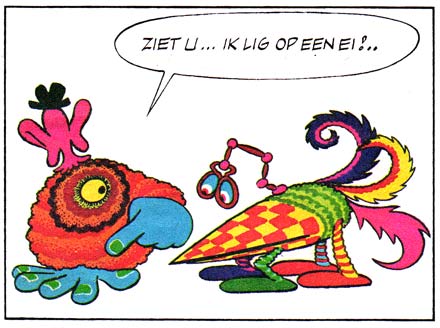Per Lygum was a Danish animator and occasional comic artist. Together with his compatriots Børge Ring and Bjørn Frank Jensen, he formed the core of the animation department of the Dutch Toonder Studio's in the 1960s. Between 1971 and 1973, he made the weird comic strip 'Planckton' for KRO Studio.
Early life and career
Per Ulvar Lygum was born in 1933. He was sixteen years old when he first set foot in Børge Ring, Bjørn Frank Jensen and Arne Rønde Christensen's animation studio in Copenhagen. He enjoyed watching the animators at work, and eventually stayed around as an apprentice. He later joined Ring and Jensen in the Netherlands, who had found employment with the Toonder Studio's in 1952. Sources differ on the exact date of Lygum's arrival. Some say it was already the following year (1953), but Ring wrote in his autobiography that they didn't hire Lygum until 1960. The threesome worked on several animated advertising spots for German clients, as well as on a piece of mute film for the British psychedelic rock band Pink Floyd, which could be projected during performances.
Børge Ring, Bjørn Frank Jensen and Per Lygum in the 1960s.
Planckton and other examples of Lygum's offbeat style
Lygum was the most eccentric of the three Danes, who had strange hobbies like underwater painting. Ring praised him for his visionary ideas and sense of innovation. His offbeat character was also typified in his bizarre comic strip 'Planckton' (1971-1973), which he made for Studio, the magazine of broadcasting corporation KRO. It was inhabited by strange and brightly colored creatures, and showcased a weird sense of humor. While the title suggests that these creatures are plankton, and some side characters indeed look like sea invertebrates, others are pure psychedelic imagination. Equally experimental were his animated films for Philips, such as a 12-minute spot about mathematics through the ages, under the title '1+1', and his 1980 spot 'Balzaal', which won an award at the Annecy Animation Festival. One of his productions for Stimorol chewing gum also won an award.
Innovation
Lygum was one of the first animators who saw possibilities in digital technology, but was confronted with the Toonder Studios' unwillingness to invest in it. At his request, the studio bought a "super computer", but instead gave it to the administration department. Lygum left Toonder in 1983, taking his assistant animator Søren Brink with him, and began his own firm at the Heerengracht in Amsterdam. Under the company name Production P.U. Lygum, he provided the first computer-animated sequence for a Danish film, 'Samson og Sally' in 1984. He experimented with 3D animation, but couldn't make his firm profitable. This was also due to the flying lessons he took on company budget. The story goes he silently hoped he'd crash his plane so he could be reunited with his deceased wife.
Still from Lygum's Tuborg commercial.
Tuborg film
Lygum's Amsterdam company eventually went bankrupt, and the animator returned to Denmark. There he made one of his best-remembered films, the mid-1980s Christmas commercial for Tuborg beer. It features Santa Claus who passes by a van with Tuborg beer and instantly turns his sled around. It has become a classic which is still repeated on Danish television around Christmas. New films were also made in the same style as Lygum's original.
German period
By the late 1980s, Per Lygum eventually went to Germany, where he had a successul career in animation in Munich, Hamburg and Berlin. He was lead animator on the movie adaptation of Gerdt von Bassewitz's fairy tale 'Peterchens Mondfahrt' (1990), animation director on the film 'Lorenz im Land der Lügner' (1997) and the TV series 'The Bunbury Tails' (1992), and art director for the TV series 'The NeverEnding Story' (1995-1996). He regularly asked his old friend Børge Ring to lend a helping hand.
Death
Per Lygum continued to work until the very end. In October 1997, he was found dead behind his computer in his Berlin home.
'Planckton'.






